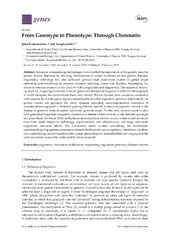| dc.description.abstract | Advances in sequencing technologies have enabled the exploration of the genetic basis for several clinical disorders by allowing identification of causal mutations in rare genetic diseases. Sequencing technology has also facilitated genome-wide association studies to gather single nucleotide polymorphisms in common diseases including cancer and diabetes. Sequencing has therefore become common in the clinic for both prognostics and diagnostics. The success in follow-up steps, i.e., mapping mutations to causal genes and therapeutic targets to further the development of novel therapies, has nevertheless been very limited. This is because most mutations associated with diseases lie in inter-genic regions including the so-called regulatory genome. Additionally, no genetic causes are apparent for many diseases including neurodegenerative disorders. A complementary approach is therefore gaining interest, namely to focus on epigenetic control of the disease to generate more complete functional genomic maps. To this end, several recent studies have generated large-scale epigenetic datasets in a disease context to form a link between genotype and phenotype. We focus DNA methylation and important histone marks, where recent advances have been made thanks to technology improvements, cost effectiveness, and large meta-scale epigenome consortia efforts. We summarize recent studies unravelling the mechanistic understanding of epigenetic processes in disease development and progression. Moreover, we show how methodology advancements enable causal relationships to be established, and we pinpoint the most important issues to be addressed by future research. | en_US |

